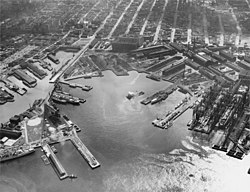
Back Brooklyn Navy Yard German Astillero Naval de Brooklyn Spanish New York Navy Yard French Brooklyn Navy Yard ID New York Navy Yard Italian ブルックリン海軍工廠 Japanese 브루클린 해군 공창 Korean Brooklyn Navy Yard Polish Brooklyn Navy Yard Portuguese Нью-Йоркская военно-морская верфь Russian
| Brooklyn Navy Yard | |
|---|---|
| Brooklyn, New York City, New York | |
 Aerial photo taken in 1918 | |
| Type | Shipyard |
| Site information | |
| Controlled by | United States Navy |
| Site history | |
| Built | 1801 |
| In use | 1806–1966 |
Brooklyn Navy Yard Historic District | |
| Location | Navy Street and Flushing and Kent Avenues Brooklyn, New York |
| Coordinates | 40°42′07″N 73°58′08″W / 40.70194°N 73.96889°W |
| Area | 225.15 acres (91.11 ha) |
| Built | 1801 |
| Architectural style | Early Republic, Mid-19th Century, Late Victorian, Modern Movement |
| NRHP reference No. | 14000261[1] |
| Added to NRHP | May 22, 2014 |
The Brooklyn Navy Yard (originally known as the New York Navy Yard) is a shipyard and industrial complex in northwest Brooklyn in New York City, New York, U.S. The Navy Yard is located on the East River in Wallabout Bay, a semicircular bend of the river across from Corlears Hook in Manhattan. It is bounded by Navy Street to the west, Flushing Avenue to the south, Kent Avenue to the east, and the East River on the north. The site, which covers 225.15 acres (91.11 ha), is listed on the National Register of Historic Places.
The Brooklyn Navy Yard was established in 1801. From the early 1810s through the 1960s, it was an active shipyard for the United States Navy, and was also known as the United States Naval Shipyard, Brooklyn and New York Naval Shipyard at various points in its history. The Brooklyn Navy Yard produced wooden ships for the U.S. Navy through the 1870s. The shipyard built the USS Monitor, the Navy's first ironclad warship, in 1862, and it transitioned to producing iron vessels after the American Civil War in the mid-1860s. It produced some of the Navy's last pre-dreadnought battleships just prior to World War I, and it performed major repairs and overhauls of its dreadnought and post-dreadnought battleships during World War II.
The Brooklyn Navy Yard has been expanded several times, and at its peak, it covered over 356 acres (144 ha). The efforts of its 75,000 workers during World War II earned the yard the nickname "The Can-Do Shipyard".[2] The Navy Yard was deactivated as a military installation in 1966, but continued to be used by private industries. The facility now houses an industrial and commercial complex run by the New York City government, both related to shipping repairs and maintenance and as office and manufacturing space for non-maritime industries.
The Brooklyn Navy Yard includes dozens of structures, some of which date to the 19th century. The Brooklyn Naval Hospital, a medical complex on the east side of the Brooklyn Navy Yard site, served as the yard's hospital from 1838 until 1948. Dry Dock 1, one of six dry docks at the yard, was completed in 1851 and is listed as a New York City designated landmark. Former structures include Admiral's Row, a grouping of officers' residences at the west end of the yard, which was torn down in 2016 to accommodate new construction. Several new buildings were built in the late 20th and early 21st centuries as part of the city-run commercial and industrial complex. A commandant's residence, also a National Historic Landmark, is located away from the main navy yard site. The FDNY's Marine Operations Division and their fireboats are located at Building 292.
- ^ "National Register Information System". National Register of Historic Places. National Park Service. January 23, 2007.
- ^ "The Can-Do Yard: WWII at the Brooklyn Navy Yard". BLDG 92. Brooklyn Navy Yard Development Corporation. Archived from the original on August 9, 2016. Retrieved August 5, 2016.


